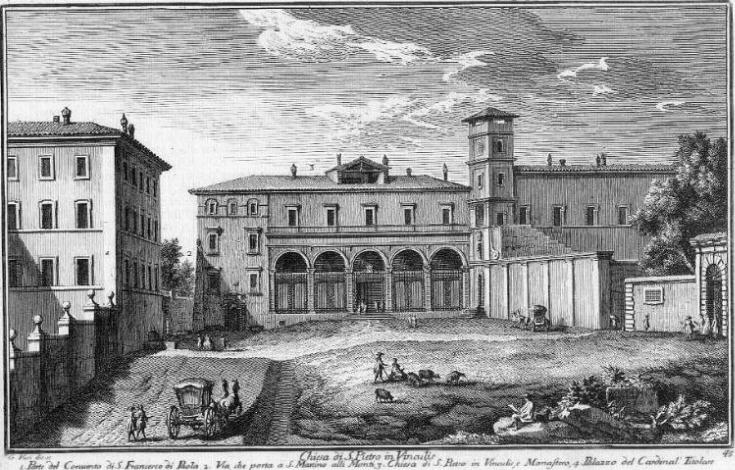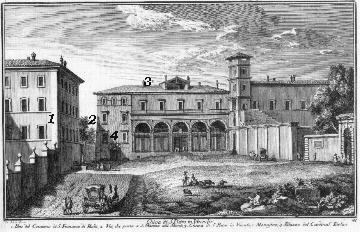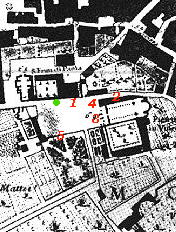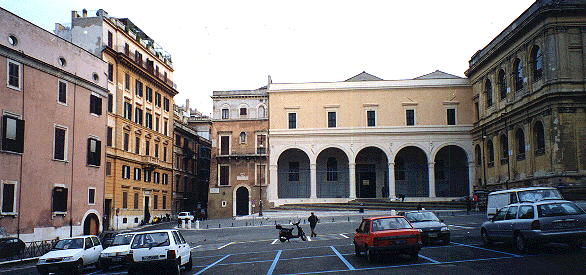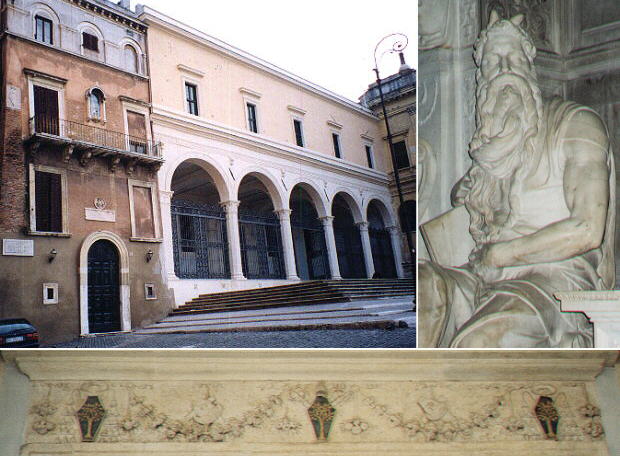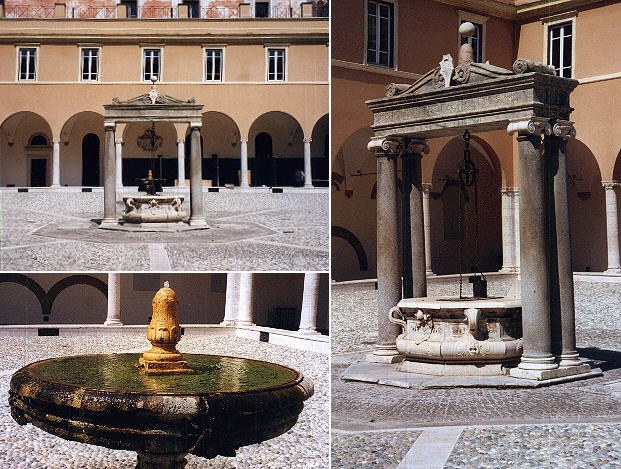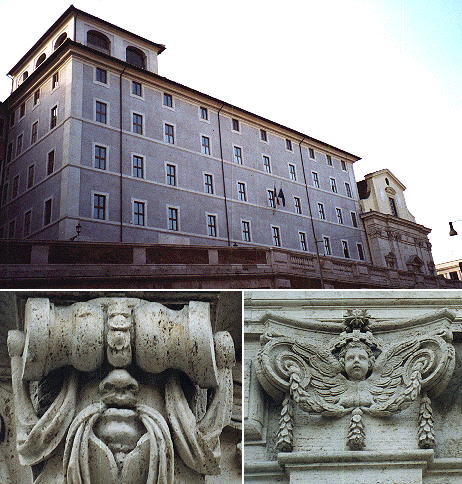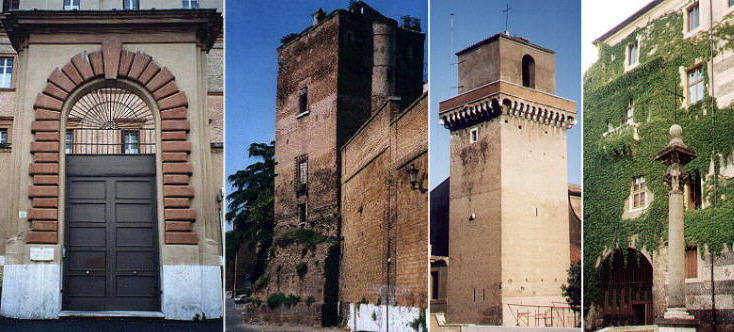

S. Pietro
in Vinculis (Book
3) (Map
B3) (Day 2) (View B8) (Rione Monti)
In this page:
The plate by Giuseppe Vasi
Today's view
S. Pietro in Vinculis
S. Francesco di Paola
S. Antonio Abate e Torri degli Annibaldi e dei Cesarini
The Plate (No. 45)
Vinculis (links but also chains) is a reference to the chains of
St. Peter for which a church was built on this site as early as 442 by
Empress Eudoxia (since Basilica Eudossiana) (in my background you see a
relief by Andrea Bregno which is inside the church and which shows the
chains). The view is taken from the green dot in the map below.
In the description below the plate Vasi made reference to: 1) Part of the monastery of S. Francesco di Paolo; 2) Street leading to S. Martino ai Monti; 3) S. Pietro in Vincoli; 4) Palace of the titular cardinal.
The small 1748 map shows also 5) Monastery of S. Antonio Abate.
Today
The tower bell and the adjoining monastery were pulled down at the
beginning of the XXth century to leave room for a section of the University
of Rome, but apart from this the simple Renaissance fašade built by Meo
del Caprina in 1475 for Sixtus IV Della Rovere has not been altered.
S.
Pietro in Vinculis
The church is today associated with the statue of Moses by Michelangelo
and with the little part of the Tomb of Julius II which was accomplished
and which remained in Rome. The tomb was designed for the new Vatican Basilica,
where today Julius II is buried in a very simple way near the tomb of his
uncle Sixtus IV.
The cloister is now part of the University building, but it is worth
a visit.
Read William Dean Howells' account of his visit to this church in 1908.
The cloister is built in the same style as the fašade. At the center
an elegant well with the coat of arms of Julius II reminds us that this
part of Rome did not have a supply of water until Sixtus V restored the
Roman aqueducts coming from the Castelli Romani. Behind the well a little
fountain built in 1642 by Cardinal Antonio Barberini is a sign of the return
of the water on the hills. The curved lines of the small basin are interrupted
by the bees of the Barberini.
S.
Francesco di
Paola
The Church and the large monastery dedicated to St. Francis of Paola
are now isolated on high ground because of the large street (Via Cavour) built to connect the Railway Station of Termini with the Fora. The church
was built in 1623 at the expense of a Cardinal Aldobrandini (see the capital
with the Aldobrandini symbols - stars and stripes) and it has some interesting details.
S.
Antonio
Abate e Torri degli Annibaldi e dei Cesarini
The plate shows to the far right a gate which is still there. Behind
the gate there is still a monastery, but it is a relatively modern building
of no interest. The walls of the monastery retain a medieval tower in good
condition and not altered by excessive restoration. It belonged to the Annibaldi family. The Annibaldi in the XIIIth century were fierce enemies of the Frangipane who
lived not far from here in a fortified part of the Colosseum. Another medieval tower next to S. Francesco di Paola came into the possession of the Cesarini in the
XVth century and it was given a Renaissance appearance. The Cesarini hosted in the houses protected by the tower Vannozza de' Cattanei, mother of Cesare and Lucrezia Borgia, whose father was Pope Alexander VI.
For this reason the houses are called Case dei Borgia.
Excerpts from Giuseppe Vasi 1761 Itinerary related to this page:
Chiesa di S. Pietro in Vinculis
Molto celebre Ŕ la chiesa, che siegue appresso le dette rovine, non solo perchŔ si conservano in essa le catene, con
le quali il Principe degli Apostoli stette legato nella prigione di Gerusalemme, e le altre con le quali fu legato in Roma,
miracolosamente unitesi insieme in tempo di s. Leone Magno; ma altresý per l'antichissima tradizione, che quivi il
medesimo s. Pietro fondasse una chiesa, e vi celebrasse i divini Misteri, non giÓ con quella magnificenza, e solennitÓ,
che dipoi si fece, dopo avuta pace la Chiesa cattolica; ma con quella parsimonia, e modestia, che permettevano quei
primi tempi; perci˛ da Adriano fu rinnovata, ed ornata con antiche colonne striate, cavate forse dalle suddette terme, o
da' tempj de' gentili. Giulio II. mentre ne era Cardinale titolare, vi pose i Canonici regolari di s. Salvatore, e poi fatto
Papa rinnov˛ la chiesa, ed ordin˛ al Buonarroti , che vi facesse il suo deposito; ma per nostra disavventura non vi
fece altro, che la sola statua di MosŔ, tanto stupenda, che si guarda con ammirazione sopra tutte le opere antiche, e
moderne; il resto per˛ fu fatto da Raffaello di Montelupo. Il s. Agostino nel primo altare a destra Ŕ del Guercino da
Cento, il sepolcro col ritratto del Card. Margotti, Ŕ del Domenichino; il s. Pietro in Carcere nell'altare, che
siegue viene dal detto Domenichino; l'altro deposito col ritratto Ŕ similmente del Domenichino, e la mezza figura
di s. Margherita da Cortona nell'ultima cappella Ŕ del suddetto Guercino. Le pitture, che sono nella tribuna, furono
fatte a fresco da Giacomo Coppi Fiorentino, e del Cristo morto colla Madonna nella cappella a destra della tribuna,
non se ne sa l'autore. La prigionia di san Pietro nell'altare, che siegue, Ŕ del Nogarj, ed il sepolcro del
Card. Vecchiarelli fu fatto da due Napolitani. Siegue dopo un altare con l'immagine della ss. Vergine molto
antica, ed un Santo fatto in mosaico: nell'ultimo altare evvi una PietÓ, e nella volta il miracolo delle catene fu
dipinto da Gio: Batista Paroti Genovese. Il monastero fu fatto con disegno di Giulio da Sangallo, e le rovine, che si
vedono appresso, sono delle dette terme di Tito; quelle per˛, che si dicono le sette sale, si credono conserve di
acqua, forse per la naumachia di Nerone, che era ove vediamo il Colosseo.
Chiesa di S. Francesco di Paola ai Monti
A destra della riferita Ŕ questa chiesa, rivoltata per˛ dall'altra parte, e fu edificata dalla Principessa Panflli di
Rostano con disegno di Gio: Pietro Morandi. Sta unita al convento de' Frati del medesimo santo Titolare, ed Ŕ
ornata di varie pitture moderne; il s. Michele Arcangelo, ed il s. Francesco di Paola sono di Stefano Perugino, e i
laterali nell'ultima cappella sono di Giuseppe Chiati.
|
Next plate in Book 3: Basilica di S. Giovanni in Laterano
Next step in Day 2 itinerary: Monastero delle
Filippine
Next step in your tour of Rione Monti: Terme di Tito e di Traiano

Go
to  or to Book
3 or to my Home
Page on Baroque Rome or to my Home Page on Rome
in the footsteps of an XVIIIth century traveller.
or to Book
3 or to my Home
Page on Baroque Rome or to my Home Page on Rome
in the footsteps of an XVIIIth century traveller.
|


